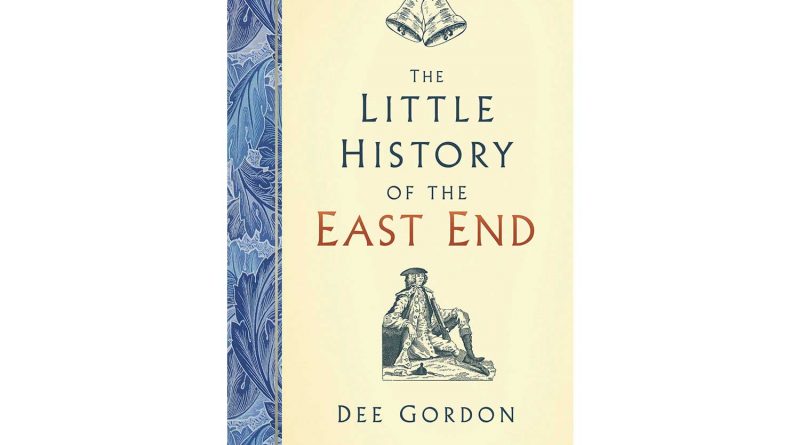Book review: The Little History of the East End
Our book reviewer Tabitha Potts reads the Little History of the East End, which is a compact little hardback by Dee Gordon sketching the broad strokes of how the East End evolved through time, with a special focus its more ancient origins, from the Stone Age to the Romans.
This attractive little hardback book with black and white illustrations, written by Dee Gordon and produced by The History Press, is a condensed history of the East End of London, which the author defines as bounded by the River Thames in the South, the River Lea in the East, the City of London in the West and Victoria Park on the Hackney border in the north.
The story of East London is told consecutively by the author, who was born in Whitechapel, and deliberately avoids some of the darker parts of its history such as the murders of Jack the Ripper, as Gordon wants to focus on ‘local change and growth’. It’s an ambitious agenda, but one this book carries out with great panache despite its brevity.
The story begins with ‘From the Stone Age to the Romans’ and the first skeleton discovered in the area, dating from as early as 3900 BC, in Blackwall. Gordon covers this huge swathe of history with authority, starting with the primitive hunter-gatherers who lived in this area who worshipped river gods by making offerings to the Thames and began to cultivate plants, create tools and tame animals.
The arrival of the Romans (first in 50 B.C. with Julius Caesar and then later in 43 A.D.) brought ‘London’ into being as Londinium, a stopping place between Kent and Colchester. It was razed to the ground by Boudicca, the queen who brought an army of 100,000 men, women and children to fight the Romans. The Roman Road (yes our one), built ten years later, followed the route she took, while Old Ford is where her army crossed the river.
The book is full of intriguing survivals from the past. ‘Millwall’ was an actual wall, a bank of stones and earth dating back to the Roman era. Bethnal Green took its name from the Saxon word ‘Blithehale’ (happy corner), Bromley-by-Bow from ‘brembel’ a field of brambles and Shoreditch from ‘soersditch’ (sewer ditch) – the Saxons who succeeded the Romans left their mark on local place names. Hoxton appeared in the Domesday Book as an Anglo-Saxon farm belonging to Hocq.
With the Norman victory in 1066 came the White Tower, the first part of the Tower of London to be built. The ‘hamlets’ or villages around the Tower gave the borough its name. Henry I’s wife, Queen Matilda, gave Bow its name when she fell in the Thames at Old Ford and ordered a new bridge to be built using three arches in the shape of a bow.
As the story continues, there are glimpses of many fascinating figures who spent time in the East End – Chaucer had his rooms above the gate at Aldgate and started to write The Canterbury Tales there, for example. Cromwell lived in Stepney, which, during his lifetime was a pastoral retreat for the wealthy and the aristocracy. The first Shakespeare plays were staged in The Theatre near Curtain Road, Shoreditch.
Gordon is good at writing about ordinary East Enders too, and gives plenty of detail about the East End’s multi-racial history. The area’s rich Jewish heritage is explored thoroughly, as well as the arrival of the Huguenots. There is also a wealth of information about how exploited workers began to organise themselves, with the famous Match Girls’ Strike in Bow in 1888 being a pivotal historical moment.
The writer apologises for the ‘near-breathless’ timeline of the twentieth century chapter which summarises many events into a paragraph or two. The much-missed Blooms’ restaurant in Aldgate East, Tubby Isaac’s famous fish stall and the opening of Kelly’s pie and mash shop on the Roman Road in 1937 all get a mention, as do famous locals such as Lionel Bart and George Carey (who became the Archbishop of Canterbury) as well as visitors such as John Gielgud (who performed in Bethnal Green), Charlie Chaplin and Mahatma Gandhi.
It’s very impressive how much careful research and detail Gordon manages to include while covering such a long period of history and making it short, readable and entertaining. There is a detailed index and bibliography for anyone who wants to find out more. Occasionally, a few more maps might have helped bring the story even more vividly to life, but the illustrations that are in the book are charming and unusual. This is a book that anyone with a love of East London history would be delighted to find in their Christmas stocking.
If you liked this article, find out more about the literature of the East End.


